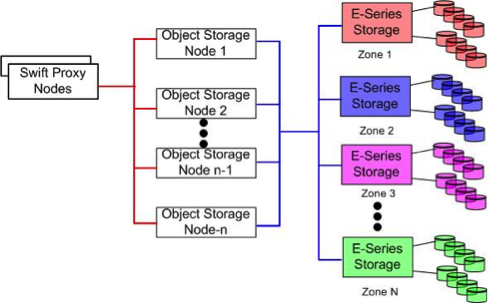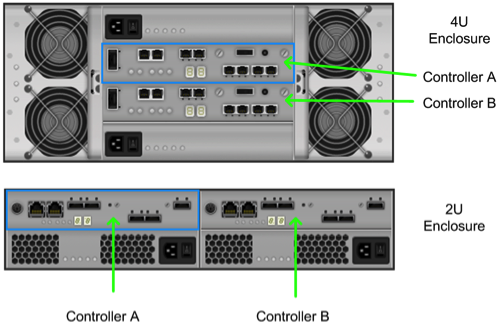Swift uses zoning to isolate the cluster into separate partitions to isolate the cluster from failures. Swift data is replicated across the cluster in zones that are as unique as possible. A zone is an arbitrary grouping of nodes; typically zones are established that use physical attributes of the cluster, such as geographical locations, separate networks, equipment racks, storage subsystems, or even single drives. Zoning allows the cluster to tolerate equipment failures within the cluster without data loss or loss of connectivity to the remaining cluster.
By default, Swift replicates data 3 times across the cluster. Swift replicates data across zones in a unique pattenr that attempts to ensure high availability and high durability for data. Swift chooses to place a replica of data in a server in an unused zone before placing it into an unused server in a zone that already has a replica of the data.
The data reconstruction feature of E-Series ensures that clients always have access to their data - regardless of drive or other component failures within the storage subsystem. When E-Series storage is used Swift data replication counts specified when rings are built can be reduced from 3 to 1.
E-Series storage offers flexible configuration options that satisfy practically all Swift zoning requirements. DDP reconstruction also eliminates the requirement of Swift data replication within a single storage array. Zoning based on E-Series storage can be done on a storage subsystem, individual controller, or drive tray basis.
Controller-subsystem based zoning. In a cluster that contains several E-Series storage subsystems zoning may be done through the use of 1 or more E-Series subsystems as a zone. An example of this is shown in Figure 8.2, “Controller-subsystem based zoning”.
Controller based zoning. E-Series storage subsystems contain two independently configurable controller modules (shown in Figure 8.3, “E-Series Controller Layout”) which in turn communicate with drives contained within the storage subsystem and optionally other externally attached E-Series drive enclosures.
For controller based zoning, each E-Series storage controller supports 2 Swift object storage nodes. Each node is connected to a single controller in the storage array. LUNs for each Swift node are configured separately on drives located within the enclosure. Additional drive enclosures may also be attached to the controller module for added storage capacity.
Drive-tray or enclosure-based zoning. If Swift cluster requirements require unique zones for each object node E-Series storage arrays can effectively provide storage capacity for multiple Swift object nodes. Disk pools are created according to desired capacity. Individual drives which comprise a disk pool are preselected by the system. Automated drive selection helps ensure that:
- Subsystem I/O performance is maximized.
- The impact of hardware failures within a drive enclosure or tray is minimized.
- I/O load on the subsystem is distributed as evenly as possible across all the drive channels in the subsystem.
If unique zoning is not required, node connectivity is only limited by the host connectivity capacity of the E-Series storage subsystem being used.




